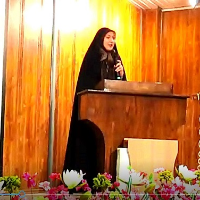Paleozoic high-temperature metamorphism and deformation related to Proto-Tethys closure and Paleo-Tethys opening in the north of Central-East Iranian Microcontinent, based on the mineralogy of Airakan metagranite
Granites are one of the most abundant rock groups formed the continental crust, and are considered for investigating the temperature conditions of their formation and metamorphism. Thus, they are a unique window to magmatism and tectonic evolution of the earth. The S-type granites are considered to be the result of crustal shearing in collision zones in the course of orogenic processes and high degrees of metamorphism (von Huene and Scholl, 1991; Brown, 2013; Hu et al., 2018). The granite might be affected and change into metagranite by further metamorphic deformations in the orogenic zones during or following the magma crystallization and emplacement of granitic melts in the continental crust. The mineralogical and textural characteristics of metagranites have a key role in understanding tectonic events and metamorphic temperature conditions and provide valuable information regarding the geological processes and Paleozoic tectonic events in the northern part of the Central-East Iranian microcontinent (CEIM).The main goal of the present paper is to investigate the high temperature-pressure metamorphism and deformation related to the of closure the Proto-Tethys oceanic crust and the opening of Paleo-Tethys oceanic crust in the north of the Central-EastIranian microcontinent, based on the petrography and mineral chemistry of Airakan metagranite.
In late Ediacaran, the Proto-Tethys Ocean between Proto-Gandwana and Proto-Laurasia opened (Raumer et al., 2015; Rossetti et al., 2015). Following several metamorphic events, the Proto-Tethys Ocean closure occurred at late Ordovician to early Carboniferous, and led the Precambrian terrains of Iran to collide and re-joint to form the Gondwana supercontinent (Raumer et al., 2015; Rossetti et al., 2015; Moghadam et al., 2017).Iran is a part of the western lands of the Gondwana supercontinent, moved to Eurasia in the early Permian-Triassic and following the Cimmerian orogeny, and then, with the Alpine-Himalayan orogeny event, until now, it has undergone several complex metamorphic, igneous, and tectonic processes, and various structural and geological zones have emerged in the land of Iran.Central-East Iranian microcontinent is composed of four main Pan-African continental plates, including (from east to west) Lut block, Tabas block, Posht-Badam block, and Yazd block. Airakan granite is a deformed and fractured Ordovician granite,exposed among the Miocene Upper Red Formation to the north of the Khor area in Yazd block (Northeastern Isfahan Province, Central Iran) (Shirdashtzadeh et al., 2018). The overall textural and mineralogical characteristics of the study granite point to its deformed/metamorphosed following the post magmatic metamorphic processes at sub-solidus temperatures (Bagheri and Stampfli, 2008; Shirdashtzadeh et al., 2018). U-Pb zircon dating (Shirdashtzadeh et al., 2018), revealed the Ordovician age (487.6 Ma) for the Airakan granite. The occurrence of Ordovician magmatism has also been reported in the other parts of the Gondwanan continental crust of Iran, Pakistan, and Tibet (e.g., Hu et al., 2015; Moghadam and Stern 2015; Naeem et al., 2016; Moghadam et al., 2018; Khodami et al., 2022; Samadi et al., 2022).
Following the microscopic observations, the selected thin sections were used for electron microprobe analysis of minerals using a JEOL JXA8800R device at an accelerating voltage of 15 kV and a current beam of 15 nanoamperes at Kanazawa University, Japan.
A) High P-T Metamorphism related to Proto-Tethys Ocean closure Thermobarometry data based on the mineral chemistry (and the whole rock composition) indicate that the Airakan S-type granite was a result of greywacke anatectic melting, due to an Ordovician HPT metamorphism. This HPT metamorphism has occurred during the closure of Proto-Tethys ocean. Consequently, collision between the Gondwana and Eurasia supercontinents has resulted in the continental crust thickening and anatectic melting. Similarly, several Ordovician anatectic S-type granites are reported from China (Hu et al., 2015), Pakistan (Naeem et al., 2016), and Central Iran (e.g., Moghadam et al., 2018; Khodami et al., 2022; Samadi et al., 2022). B) Metamorphic deformation related to Paleo-Tethys Ocean Opening A metamorphic deformation caused by the opennig of Paleo-Tethys Ocean in late Ordovician to early Devonian-Carboniferous (Bagheri and Stampfli 2008) has recorded in the Airakan metagranite in the north of CEIM. According to mica crystals orientation, metamorphic deformations of quartz (GBM recrystallization, subgrains formation and elongation, as well as preferential orientation or SSPO of quartz), and feldspars (formation of flame perthite parallel to the maximum stress (σ1), myrmekitization, tartan texture and BLG recrystallization around feldspars), in 382 Ma, the Airakan granite has undergone a metamorphic deformation at ~500 to 700 °C in a shear zone.
Geothermobarometry results based on the mineral chemistry as well as the whole rock composition of Airakan metagranite indicate that a high temperature-pressure metamorphism has resulted in an anatexis event (dehydration of mica) at temperature of ~817-850℃. This event is consistent with the continental collision and of ancient continental crust thickening in the north of Yazd block during the closure of the Proto-Tethys Ocean starting from Greece to Iran and the Himalayas and, the Pan-African orogeny, from the Precambrian to the beginning of Ordovician.In addition, petrographic features (e.g., the flame perthite, myrmekite, and recrystallization of quartz and feldspars) show that Airakan granite has undergone an approximately high-grade metamorphic deformation in a deep shear zone at ~ 500-700 ℃. Based on previous geochronological data (382 Ma), it was a consequence of Paleo-Tethys evolution in the active continental margin of the southern Eurasia in Upper Devonian.
- حق عضویت دریافتی صرف حمایت از نشریات عضو و نگهداری، تکمیل و توسعه مگیران میشود.
- پرداخت حق اشتراک و دانلود مقالات اجازه بازنشر آن در سایر رسانههای چاپی و دیجیتال را به کاربر نمیدهد.


